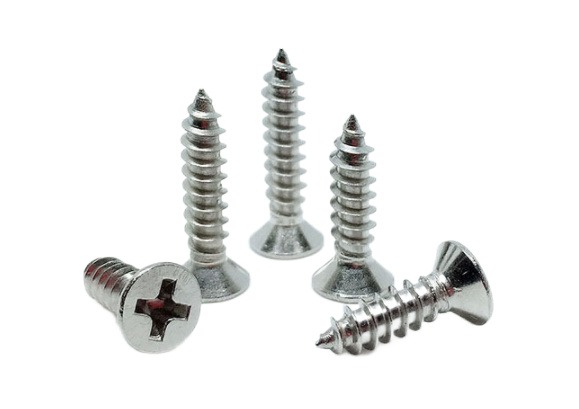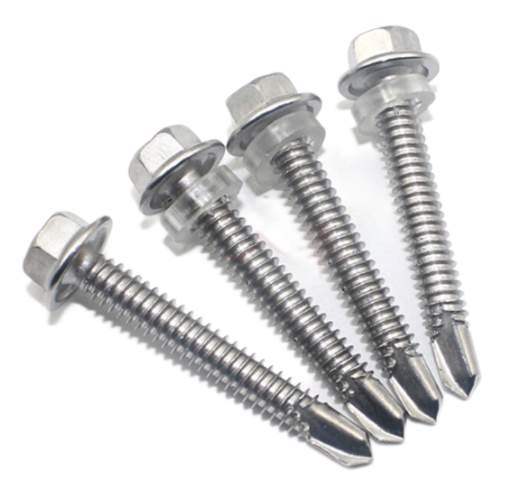Self-tapping screws are commonly used to connect thin metal plates such as steel plates and saw blades. When connecting, first drill a threaded bottom hole in the linked piece, then screw the self-tapping screw into the threaded bottom hole.
The self-tapping screw on the consolidated material can drill one of the matched female threads in the pre-drilling of metal or non-metallic materials by its own thread. Its primary application is to join thin metal plates such as thin iron sheet, copper sheet, aluminium alloy, and other metals. The main distinction between self-tapping screws and conventional screws is that self-tapping screws have a pointed head and can pass through walls or other metal materials without drilling. It not only reduces the workload of fixed projects, but it also has user-friendly properties, thus it is extensively utilised in household appliances.

Structure of Self-tapping Screw
A self-tapping screw is made up of three parts: the head, the rod, and the rod end. Each tapping screw has four primary components: the head form, the screwing method, the thread type, and the end type.
Shapes of screw heads
Screw heads come in a variety of forms. There is a round head, a half round head, a flat round head, a round head flange, a flat round head flange, a pan head, a pan head flange, a countersunk head, a half countersunk head, a cylinder head, a spherical cylinder head, a horn head, a hexagon head, a hexagon flange head, and so on.
Screwing methods
The screwing method relates to how the screw head is twisted during installing and tightening the screw. External screwing and internal screwing are the two most common procedures. In general, the allowed torque of an exterior wrench is greater than that of any internal wrench.
External wrench
hexagon flange face, hexagon flange, hexagon torx, and so on
Internal wrench
Internal spline, internal hexagonal spline, internal triangle, internal hexagon, internal 12 corner, clutch slot, six-blade slot, high torque cross slot, and so on.
Types of screw threads
Screw threads come in a variety of shapes and sizes, including self-tapping thread, machine thread, plasterboard screw thread, fiberboard screw thread and other specialised threads. Screw threads are further classified as single lead, double lead, multiple lead, and high and low teeth double head threads.
Screw end forms
Ends are classified into two types: cone ends and flat ends. However, depending on the application, the screw-in end can process grooves, notches, or sections comparable to the shape of the drill bit.
Features of Self-tapping Screw
1. A self-tapping screw is a screw that has a drill bit attached to it. A unique electric tool is used to make the hexagonal socket bolt. Drilling, tapping, fastening, and locking are all done at the same time. The self-tapping screw is mostly used for connecting and fixing some relatively thin parts, such as the connection of colour steel plate to colour steel plate, the connection of colour steel plate to purlin, the connection of wall beam, and so on. Its penetrating capacity is often no more than 6mm, with a maximum of 12mm.
2. Self-tapping screws are frequently exposed to the elements and have a high corrosion resistance. Its rubber sealing ring prevents water from entering the screw.
3. The self-tapping screw, also known as wood screws, is appropriate for usage with wood products. They are typically operated by hand. Due to labour constraints, these screws are often quite small, with a limited range of applications.
4. The self-tapping screw integrates the tap and the bolt. The tap is on the front, and the thread is on the back. Drill a hole in normally soft materials and then screw it in immediately. Tap out the thread before tightening the bolt thread. If the screw diameter is tiny enough and the material is soft enough, it can even be screwed into wood without prior drilling.
5. Self-tapping screws are typically defined by three parameters: screw diameter series, threads per inch length, and screw length. There are 10 and 12 screw diameter levels, with screw sizes of 4.87mm and 5.43mm, respectively. Threads per inch length is available in 14, 16, and 24 levels.

How Can Self-tapping Screws Be Easily Installed?
The main advantage of self-tapping screws is that they do not require nuts and can be locked and attached by their own thread. It is a pretty commonly used screw in everyday life. When self-tapping screws are inserted into holes in plastic metal materials, extrusion can generate internal threads in the holes, which is the primary function of self-tapping and self-drilling.
Self-tapping screws can be installed with an air screwdriver, a screwdriver, a pistol drill, or an electric hammer. In most cases, an electric hammer is required to drive concrete. Ordinary nails cannot be used to nail concrete walls with a mark over C10, however cement steel nails can be used directly if the bearing gravity requirements are not severe. If there is a high load bearing need, it must be secured using expansion screws, common plastic expansion pipes, and self-tapping screws.